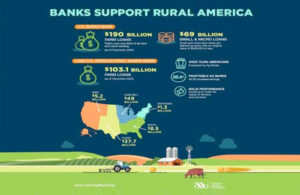Record Lending by U.S. Farm Banks Bolsters Rural Economy
U.S. farm banks set a new lending record in 2022, with loans totaling $103.1 billion, marking an 8.1% increase from the previous year, as reported in the American Bankers Association’s (ABA) annual Farm Bank Performance Report. The increase in lending occurred despite global supply chain disruptions, commodity price volatility, geopolitical uncertainty, and other challenges.
Farm Bank Lending
The ABA report pinpointed the principal factors that drove this surge in lending as the 9.7% increase in outstanding loans secured by farmland and a 5.9% rise in agricultural production loans. Moreover, the report showed that farmland values had strongly increased in 2022, following a plateau of several years. This, in turn, provided a sturdy equity base for producers.
Farm Bank Holdings
Farm banks held over $43.8 billion in small farm loans, including $9.3 billion in micro farm loans at the end of 2022, underscoring the crucial role they play as a major source of credit to small farmers. Additionally, the report highlighted that these banks maintained a strong asset quality, with noncurrent loans constituting 0.49% of the loan portfolio at the end of the year.
The report also presented a regional breakdown of farm bank performance. Farm loans decreased by 13.08% to $1.3 billion in the Northeast region. In contrast, the South, Cornbelt, Plains, and West regions saw increases of 11.98%, 8.83%, 5.98%, and 10.47%, respectively.
Farm Banks Show Resilience
Farm banks showed resilience, according to ABA, by demonstrating strong asset quality and maintaining healthy capital levels. Despite a 15.4% decrease in equity capital, Tier 1 capital saw an increase of 8.7% to $50.9 billion in 2022.
Overall, the ABA report affirmed that farm banks have been key in supporting small farmers, with small loans representing over a third of banks’ farm and ranch lending. In addition, farm banks expanded their workforce by 1.1% in 2022, adding more than 800 jobs and employing over 75,000 rural Americans.

Farm banks – ABA infographic
The Farm Bank Performance Report Regional Summaries
- Northeast Region 9 banks decreased farm loans by 13.08% to $1.3 billion in 2022. Ag production loans fell 2.96% from 2021, farmland loans increased 14.53%.
- South Region 137 banks increased farm loans by 11.98% to $8.5 billion in 2022. Ag production loans rose 14.87% from 2021, farmland loans rose by 11.00%.
- Cornbelt region 694 banks increased farm loans by 8.83% to $49.0 billion in 2022. Ag production loans rose by 7.44% from 2021, farmland loans rose by 9.80%.
- Plains region 574 banks increased farm loans by 5.98% to $37.7 billion in 2022. Ag production loans rose 2.51% from 2021, farmland loans increased 9.07%.
- West region 45 banks increased farm loans by 10.47% to $5.2 billion in 2022. Ag production loans rose by 13.86% from 2021, farmland loans rose 8.27%.
- Read more
Key Takeaways
- Agricultural lending by U.S. farm banks increased 8.1% to $103.1 billion.
- Outstanding loans secured by farmland and agricultural production loans drove the increase.
- Farmland provides a strong equity base, with land values seeing strong growth in 2022.
- Farm banks are a major source of credit to small farmers.
- Asset quality at farm banks improved in 2022, with low loan delinquency.
- The banking industry held nearly $190 billion in farm and ranch loans.
- The Northeast region decreased farm loans, while the South, Cornbelt, Plains, and West regions increased.
The ABA report underscores the pivotal role of the US banking industry that provides essential funding to small farmers. More than one-third of farm and ranch lending consists of small loans, reflecting a commitment to this sector. By the end of 2022, the volume of small and micro farm and ranch loans exceeded $69 billion. Despite the hurdles faced, farm banks showed a solid commitment to supporting rural employment, adding over 800 jobs in 2022, a growth of 1.1%, and providing employment to more than 75,000 rural Americans.




